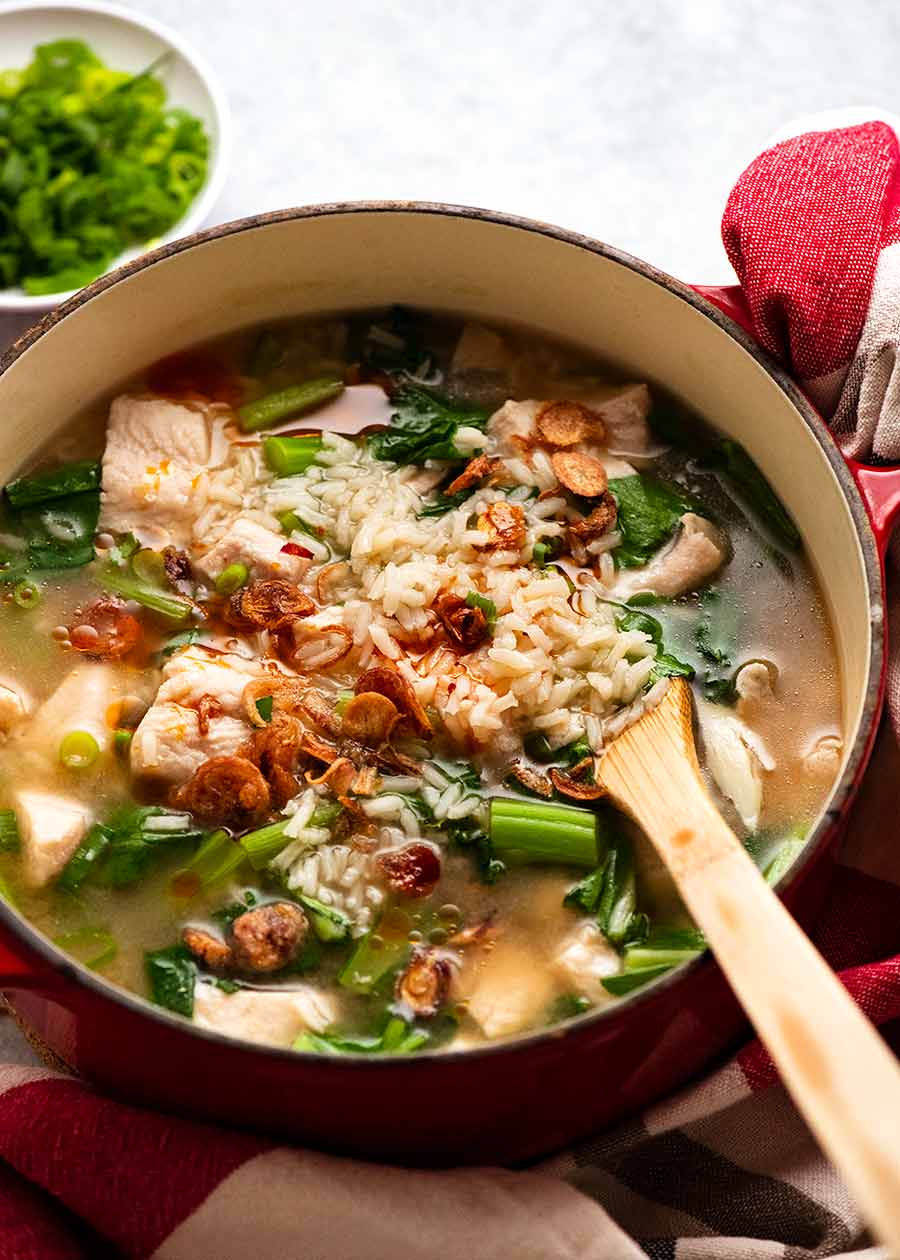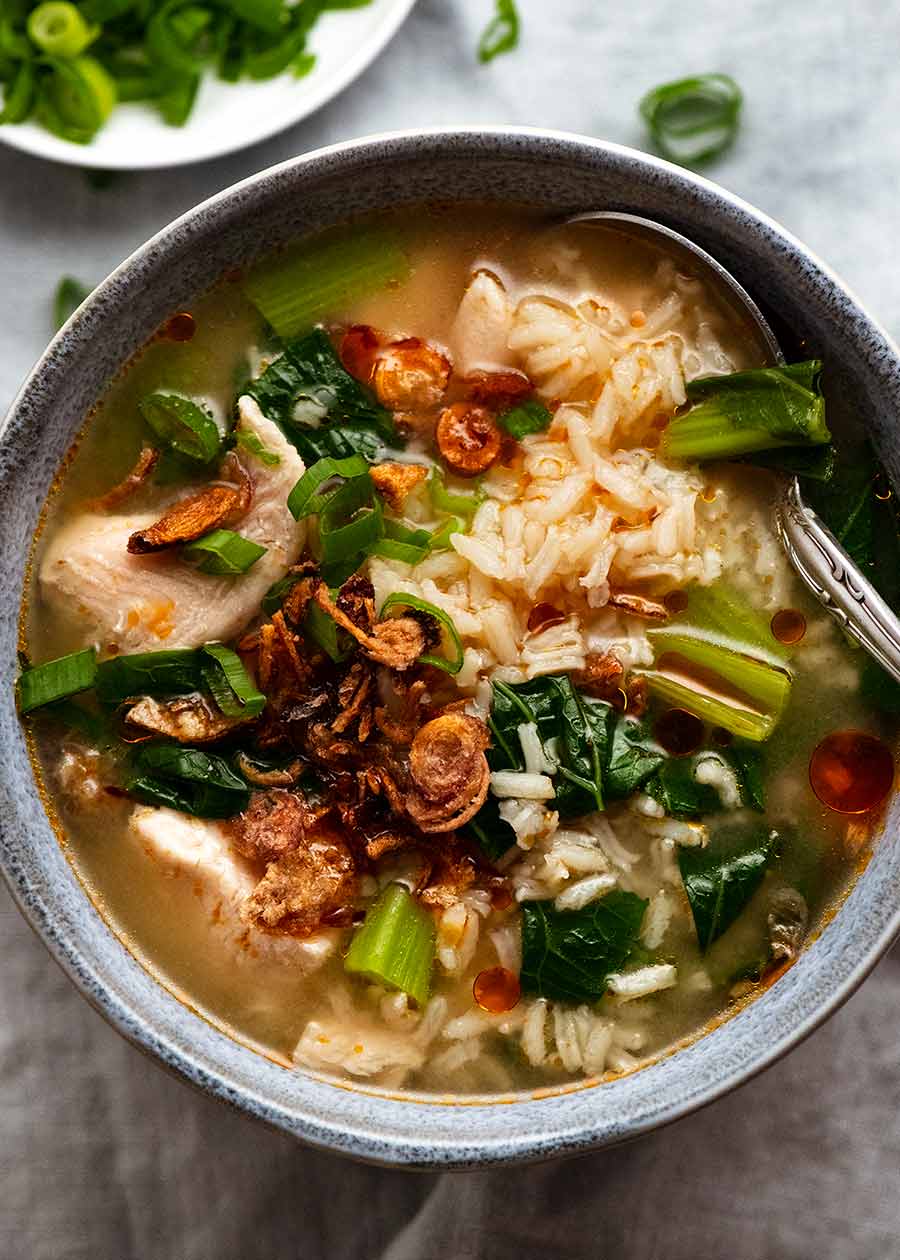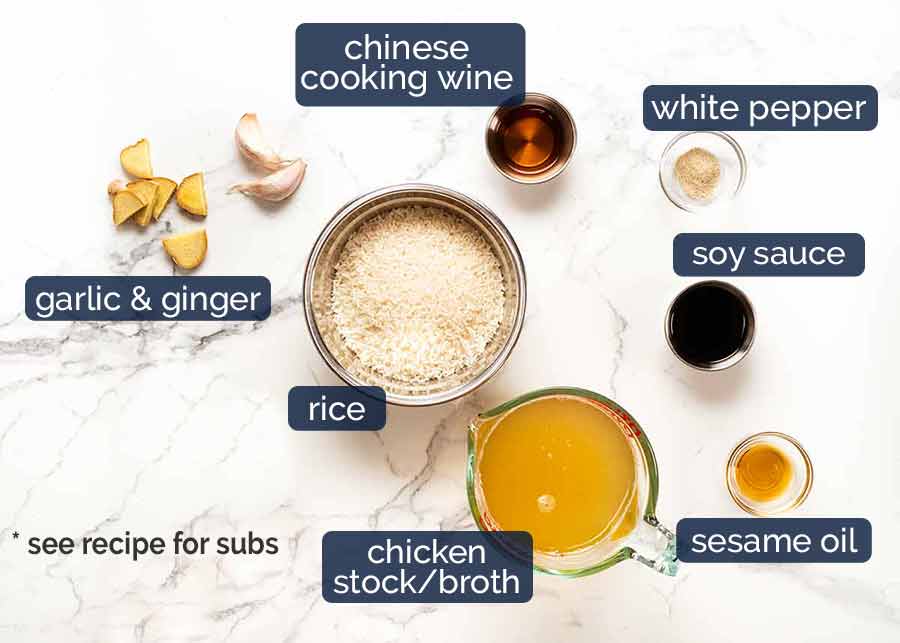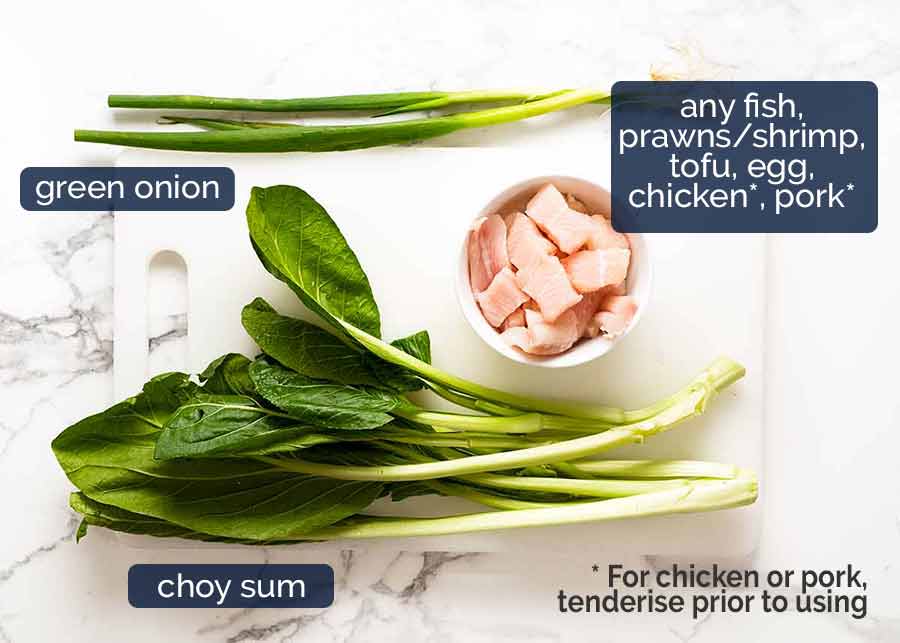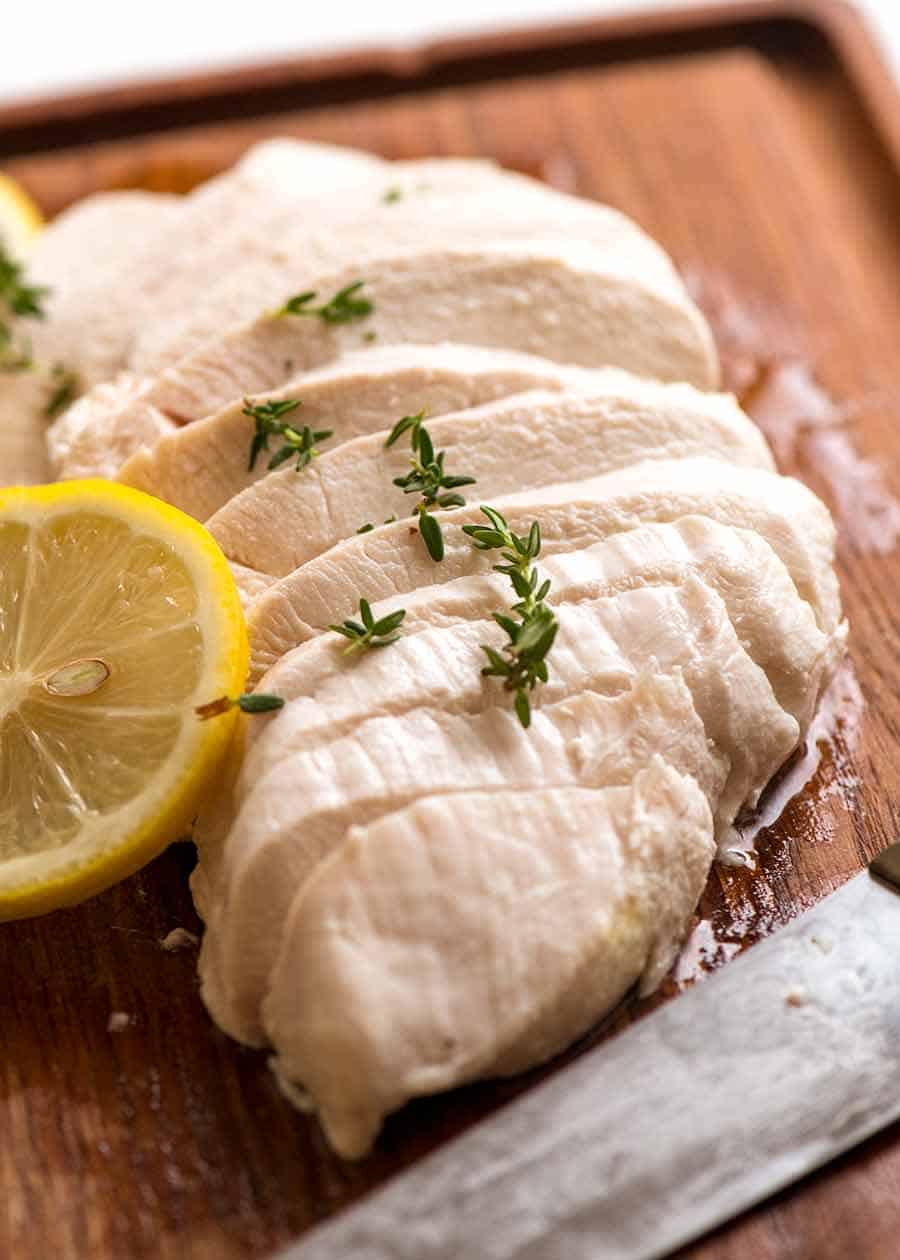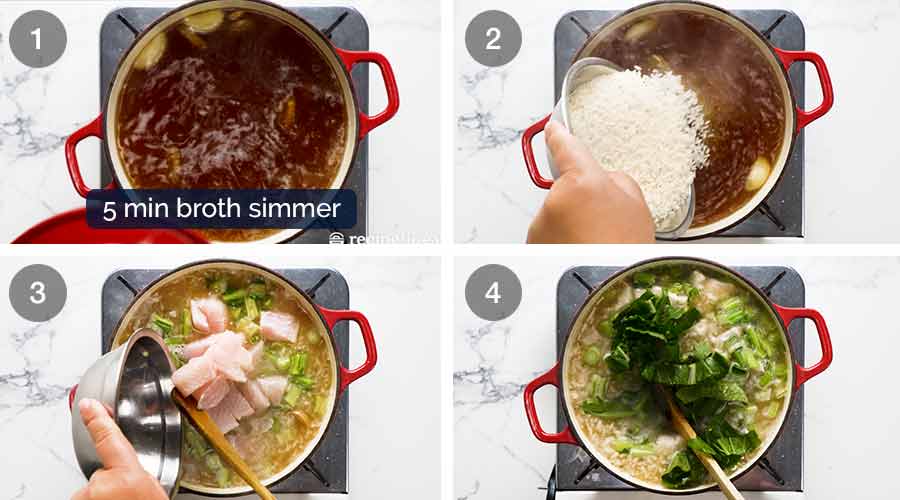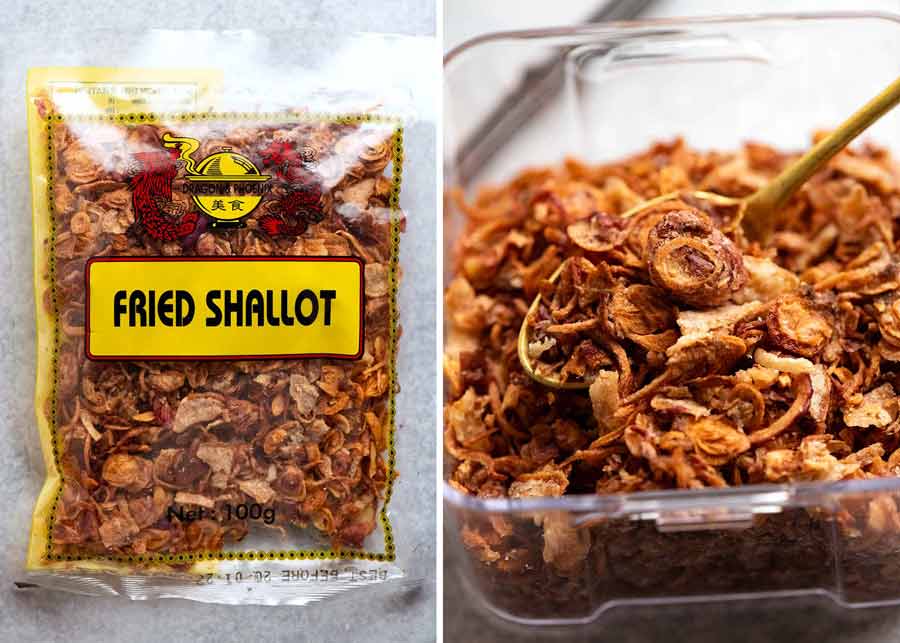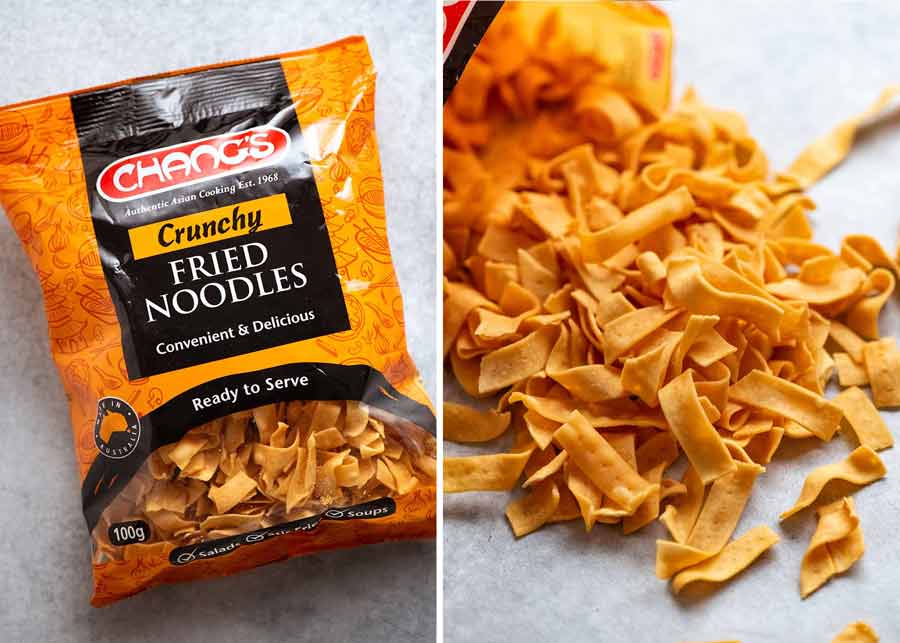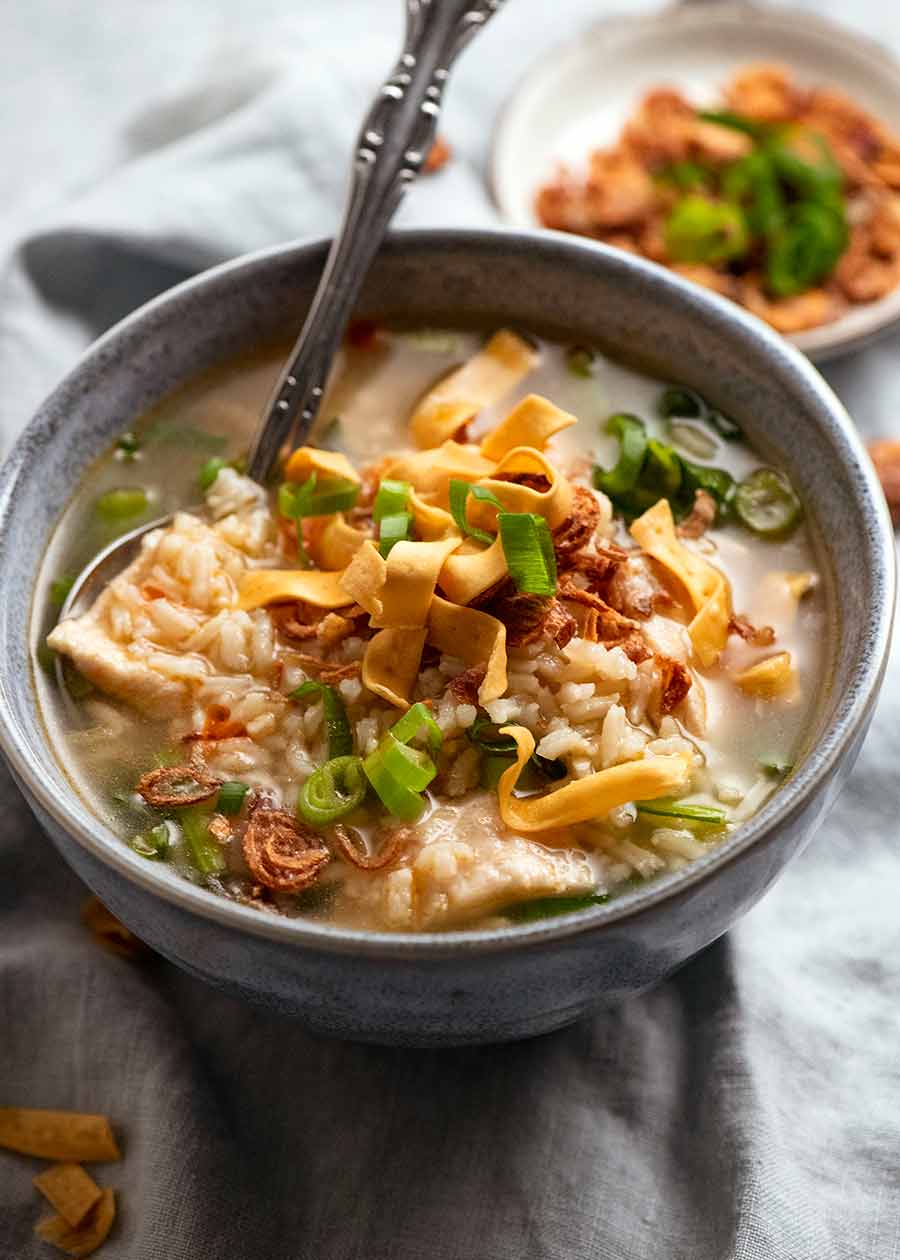In the spirit of simplicity and speed, I’ve just used fish and choy sum. But it’s excellent with shrimp/prawns, chicken, pork or even leftover cooked meats!
Quick and Easy Chinese Rice Soup
This rice soup is a really good, quick low effort meal that’s extremely versatile. Based around a simple Chinese soup broth used in several recipes I’ve previously shared, including this Chinese Noodle Soup, I think the feedback from a reader is all you need to know about this broth: “The depth of flavour is incredible for such a simple, quick, easy soup.” – Jay, 2 September 2020 on Chinese Noodle Soup Succinct, and to the point!
What goes in the Chinese soup broth
In this recipe, I’m using the Chinese soup broth to make a rice soup. Here’s what you need for the broth:
Notes on the ingredients:
Rice – virtually any standard white rice will work just fine in this rice soup. Long grain, medium grain, short grain, jasmine, basmati. I’ve also popped directions for recipe adjustments required to make this with brown rice – most varieties take longer to cook so you’ll need more liquid; Chicken stock/broth – low sodium is best, so it’s not too salty once you add the soy sauce and Chinese cooking wine (both of which add salt and flavour). Vegetable stock also works; Chinese cooking wine – the key ingredient in all Chinese cooking that adds depth of flavour to anything it’s used in, from fried rice to stir fries, to noodles and marinades such as sticky Chinese Wings, Ribs and even crispy Pork Belly. It’s got a small amount of alcohol in it (wine level), but we only need 1 tablespoon so the alcohol mostly cooks out during the simmer stage; Soy sauce – we’re using light soy sauce here so as not to discolour the rice soup broth. Read more about different soy sauces here; Sesame oil – toasted sesame oil is added at the end for a lovely perfume of sesame flavour. Untoasted sesame oil is yellow and the flavour is not as strong, so don’t use that. Here in Australia, toasted sesame oil (which is brown) is the standard – it’s harder to find untoasted; Fresh garlic & ginger – simmered in the broth to infuse with flavour; and White pepper – white rather than black pepper is the standard in Chinese cooking so you don’t get black specks. But black pepper works just fine too.
Chinese Rice Soup Add-ins
This is the part that’s entirely customisable. I’ve just used choy sum and fish, both of which are low effort to prep plus super-quick to chop. Plus green onion to add a touch of freshness at the end. See below for an extensive list of alternatives. Basically, anything that’s blanch-able!
Rice Soup Add-Ins
These are the add-ins I used, but see below for a rather extensive list of alternatives. I did say this was a flexible recipe!!
Fish – I like using fish because it drops juice that adds extra flavour into the broth, plus it’s super quick to cook and requires no seasoning prior to use. You can use virtually any fish here – white fish fillets, salmon, trout. For white fish, firm-fleshed fish are ideal, such as:
tilapia cod (all types) mahi-mahi halibut basa snapper barramundi ling (this is what I used)
Fish best avoided include:
Fish that easily goes dry if cooked too long – tuna, bonito, swordfish, marlin, kingfish Very oily fish – sardines, mullet, herring, mackerel (too strongly flavoured for this soup) Delicate-textured white fish – flathead, gemfish/hake, sole (not ideal as they can break up easily, but are still OK if you’re careful)
(Tip: These fish selection guidelines are good for any recipes where fish are braised or poached like this, such as Moqueca (Brazilian Fish Stew) and Goan Fish Curry.)
Choy sum – this is a Chinese vegetable which is widely available here in Australia. The stem has a juicy bite to it like soft celery and the leaf is similar to spinach but it’s not as fine. Quick to chop and cook. Any other Chinese vegetable will be an ideal substitute – or other vegetables that can be simmered; and Green onion – for a sprinkle of freshness at the end.
Alternative Add-ins
Here are some other add-ins that will work really well with this recipe:
Prawns/shrimp – very quick to cook, just plonk the raw prawns straight into the broth. No need to season beforehand. Large prawns will take 3 minutes to cook, medium 2 minutes, small 1 minute; Chicken – slice it thinly, then tenderise it using this simple Chinese velveting method to ensure it stays soft and tender even after simmering. After tenderising, toss with a pinch of salt and pepper prior to cooking. Use breast or boneless thigh, simmer for 2 minutes; Pork – as above with chicken (including tenderising). Use tenderloin, scotch fillet or chops, thinly sliced into strips. Simmer for 2 minutes; Firm Tofu – cut into small batons, like in Hot & Sour Soup; Cooked chicken – make poached chicken (use this Foolproof Method for the juiciest poached chicken of your life!), then slice it and place on top of soup once served in bowls. Or use any cooked chicken, shredded or diced; Other cooked proteins – any other cooked protein that’s relatively plain or has Asian flavours. A bit of leftover Char Siu (Chinese BBQ Pork or Chicken), or perhaps if you have some leftover Asian flavoured mince (ground meat) such as from these quick Asian Beef Bowls, Vietnamese Caramelised Pork Bowls, or even the stuffing for San Choy Bau (Chinese Lettuce Wraps) or Thai Lettuce Wraps. Any of these would be terrific! Other vegetables – any vegetable that cooks well in liquid will work well here. Think: sliced carrots, zucchini/courgettes, broccoli/broccolini, cauliflower, asparagus, beans.
How to make Chinese Rice Soup
This recipe has a nice flow to it, which is partly what makes it so low effort:
Pour chicken stock into pot and as it comes to the simmer, slice the ginger, peel the garlic, measure out the soy sauce and Chinese cooking wine and plonk it in; As the broth simmers for 5 minutes to infuse with flavour, prepare the rice, fish and choy sum; then As the rice and fish are cooking, get the bowls out and your choice of toppings out for serving.
Toppings
As for toppings – a little pinch of store bought crispy fried shallots and crunchy noodles really elevates this soup to another level. Don’t get me wrong – this rice soup is delicious as is and I’ve eaten it naked plenty of times, but crunchy toppings are the cherry on top! Using both is the ultimate combo, but even using one of these is terrific / highly recommended.
1. Crispy Fried Shallots
One of my favourite Asian garnishes to add a pop of crispiness and salty goodness into Asian soups and salads. They are literally shallots fried until crunchy, then sprinkled with salt. Sold in the Asian section of grocery stores, but much cheaper at Asian stores!
2. Crunchy fried noodles
The big sister of the thin crunchy noodles used in things like Chinese Chicken Salad, these are like the strips of fried wontons that come with Congee, the traditional slow cooked, porridge-like Chinese rice soup. Excellent crunch factor! Sold in the Asian food section of mainstream grocery stores, here’s what it looks like:
What to serve with Chinese Rice Soup
This soup as written is a bit light on the vegetables so by all means, feel free to increase the vegetable quota by adding more greens. Alternatively, serve it with a side salad or steamed greens tossed in a simple Asian Sesame Dressing, or a big Asian Slaw.
Storing leftovers
Rice left in soup will continue to absorb the liquid and become unappealingly bloated, so if you’ve got leftovers, it’s essential to separate them. Either scoop the rice out with a slotted spoon, or drain using a colander, then store the rice in a separate container to the broth. Resist the temptation to cook the rice separately and place in bowls before ladling broth over because we want the rice to absorb the tasty flavours of the broth as it cooks! – Nagi x
Watch how to make it
Life of Dozer
A lot of golden retrievers are coordinated enough to do this on dry land. Dozer needs the full assistance of water buoyancy to get up on this hind legs without slamming his paws onto someone for support (usually me). (PS This is his “pretty please, play with me?!” pose)
